搜索结果: 1-15 共查到“天体物理学 galaxy”相关记录128条 . 查询时间(0.078 秒)
Tsunami of Stars and Gas Produces Dazzling Eye-shaped Feature in Galaxy
Tsunami Stars Gas Dazzling Eye-shaped Galaxy
2016/11/29
Astronomers using the Atacama Large Millimeter/submillimeter Array (ALMA) have discovered a tsunami of stars and gas that is crashing midway through the disk of a spiral galaxy known as IC 2163. This ...
WVU astrophysicists part of gravitational wave search that provides insights into galaxy evolution and mergers
WVU astrophysicists gravitational wave search galaxy evolution and mergers
2016/4/13
On the heels of their participation in the historic research that resulted in the detection of gravitational waves, West Virginia University astrophysicists continue to plow new ground ...
Dark matter is called "dark" for a good reason. Although they outweigh particles of regular matter by more than a factor of 5, particles of dark matter are elusive. Their existence is inferred by thei...

ALMA Weighs Supermassive Black Hole at Center of Distant Spiral Galaxy(图)
ALMA Weighs Supermassive Black Hole Distant Spiral Galaxy
2015/7/13
Supermassive black holes lurk at the center of every large galaxy. These cosmic behemoths can be millions to billions of times more massive than the Sun. Determining just how massive, however, has bee...

Magnetic-Field Discovery Gives Clues to Galaxy-Formation Processes(图)
Magnetic-Field Gives Clues Galaxy-Formation
2015/7/13
Astronomers making a detailed, multi-telescope study of a nearby galaxy have discovered a magnetic field coiled around the galaxy's main spiral arm. The discovery, they said, helps explain how galacti...
Why Do Starburst Galaxies 'Burst'? ALMA Sees Super Stellar Nurseries at Heart of Sculptor Galaxy
Starburst Galaxies Burst Super Stellar Nurseries Heart of Sculptor Galaxy
2015/3/4
Starburst galaxies transmute gas into new stars at a dizzying pace – up to 1,000 times faster than typical spiral galaxies like the Milky Way. To help understand why some galaxies "burst" while others...
Astronomers using the National Science Foundation's Very Large Array (VLA) found surprisingly energetic activity in what they otherwise considered a "boring" galaxy, and their discovery provides impor...

Map of Mysterious Molecules In Our Galaxy Sheds New Light on Century-Old Puzzle(图)
Map of Mysterious Molecules Our Galaxy Light on Century-Old Puzzle
2015/1/20
The map, which can be viewed at http://is.gd/dibmap, was unveiled Jan. 8 at the 225th meeting of the American Astronomical Society in Seattle. The map will be discussed at a 2:15 p.m. PST press confer...

Newly detected short radio pulse appears to come from far beyond our galaxy(图)
Radio telescopes Pulse A quick radio burst Signal Radio The pulsar. The observatory The Milky Way
2014/7/18
The discovery of a split-second burst of radio waves using the Arecibo radio telescope in Puerto Rico provides important new evidence of mysterious pulses that appear to come from deep in outer space.
A remarkable long-term light curve, and deep, low-state spectroscopy: Swift & XMM-Newton monitoring of the NLS1 galaxy Mkn 335
remarkable long-term light curve low-state spectroscopy Swift XMM-Newton monitoring the NLS1 galaxy
2012/2/23
The Narrow-line Seyfert 1 galaxy (NLS1) Mkn 335 is remarkable because it has repeatedly shown deep, long X-ray low-states which show pronounced spectral structure. It has become one of the prototype A...
The Search for High-Mass X-ray Binaries in the Phoenix Dwarf Galaxy
High-Mass X-ray Binaries Phoenix Dwarf Galaxy
2012/2/23
We report on the first X-ray images of the Phoenix dwarf galaxy, taken with \emph{XMM-Newton} in July 2009. This local group dwarf galaxy shares similarities with the Small Magellanic Cloud (SMC) incl...
Galaxy Zoo: Dust and molecular gas in early-type galaxies with prominent dust lanes
galaxies: ISM - galaxies: elliptical and lenticular cD - galaxies: peculiar galaxies: interactions - galaxies: formation - galaxies: evolution
2011/10/17
We study dust and associated molecular gas in 352 nearby early-type galaxies (ETGs) with prominent dust lanes. 65% of these 'dusty ETGs' (D-ETGs) are morphologically disturbed, suggesting a merger ori...
Gas and dust in a submillimeter galaxy at z = 4.24 from the Herschel ATLAS
submillimeter galaxy Herschel ATLAS
2011/10/9
We report ground-based follow-up observations of the exceptional source, ID141, one the brightest sources detected so far in the H-ATLAS cosmological survey. ID141 was observed using the IRAM 30-meter...
The Age-Metallicity Relation in the Thin Disk of the Galaxy
metallicity relation thin disk of the Galaxy
2011/9/30
HST trigonometric distances, photometric metallicities, isochronic ages from the second revised version of the Geneva--Copenhagen survey, and uniform spectroscopic Fe and Mg abundances from our master...
Galaxy And Mass Assembly (GAMA): the red fraction and radial distribution of satellite galaxies
surveys – galaxies star formation – galaxies interaction – galaxies
2011/8/24
We investigate the properties of satellite galaxies that surround isolated hosts within the redshift range 0.01 < z < 0.15, using data taken as part of the Galaxy And Mass Assembly survey. Making use ...

